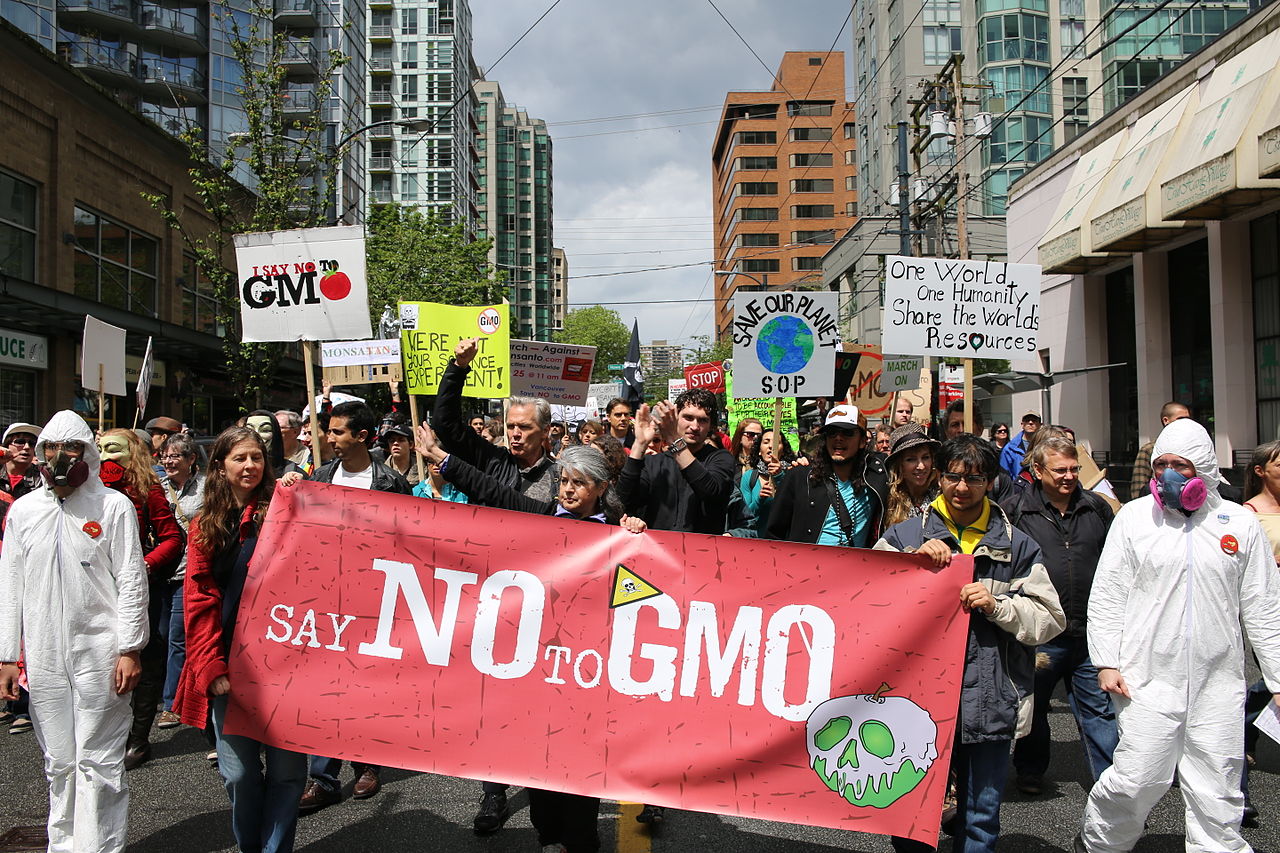By Clément Paule
Translation: Pierre Chabal
Passage au crible n°78
 Source : Wikipedia
Source : Wikipedia
Published on September 19, 2012, the study led by Gilles-Eric Séralini – professor of molecular biology at the Caen University, France – revived the debate on GMOs (Genetically Modified Organisms) and their use in the food industry. The findings of this research, to be sure, point to the toxicity of two chemicals produced by the Monsanto firm: the pesticide Roundup and the GM corn NK 603. These results, however, have been questioned by a large portion of the scientific community, which pointed out the statistical and methodological weaknesses of the demonstration. Some commentators have even mentioned the potential conflicts of interest of a survey funded by an association known for its militant positions. In addition, several French organizations – such as the HCB (Haut Conseil des Biotechnologies) and HANDLE (National Agency for Food Safety, Environment and Labor) – as well as some international organizations – such as EFSA (European Food Security Authority) or the German and Australian health agencies – have successively invalidated the investigations by Prof. Séralini and his team. Let us note that this controversy quickly involved many political actors – including four former Environment Ministers – and many actors from associations, across national borders. The need to assess, over the long term, the impact of transgenic plants was therefore reiterated in policymakers’ agendas, opening up the prospect of more stringent regulations at the European level.
> Historical background
> Theoretical framework
> Analysis
> References
The first genetic manipulation took place in the early 70s, leading a decade later to pioneering GMO crops. These technical advances have stimulated large private investments in biotechnology. Mainly used by pharmaceutical companies, applications of transgenesis quickly spread to agriculture under the aegis of transnational companies such as Monsanto and Bayer. In this regard, special notice ought to be paid to the introduction on the market in 1994 of the Flavr Savr tomato, the first genetically modified food to obtain the approval of the FDA (Food and Drug Administration) in the United States. More generally, the agrochemical industry born out of the Green Revolution, until then specialized in inputs – pesticides and herbicides – has now been redeployed in the production of transgenic seeds widely used throughout the American continent. According to the ISAAA (International Service for the Acquisition of Agri-biotech Applications) – lobbying organizations in favour of plant biotechnology -, 160 million hectares are said to be concerned today by these techniques – against 1.7 million in 1996 – a total area in increase by 8 % in 2011 alone. If these figures seem overestimated according to Greenpeace, one must nevertheless note that the share of GM corn grown in the United States, estimated at 30 % in 1998, reached 85 % in 2009.
In this logic, this model of agriculture has spread in so-called emerging countries as shown by the emblematic example of soybeans in Brazil and Argentina. The exponential growth of agricultural and food biotechnology has benefited in this respect from a lack of real control until the early 90s. However, the occurrence of repeated health crises in Western states – such as BSE (Bovine Spongiform Encephalopathy) – has caused the rise of citizen mobilization of transnational magnitude – from consumer associations to NGOs (Non governmental Organisations) – as well as the strengthening of legislation implemented by specialized agencies. GMOs then appeared as a public problem in several European countries. Evidence of this is the de facto moratorium on the commercialization of genetically modified products, adopted by the European Union (EU) on behalf of the precautionary principle from June 1999 to May 2004. Let us finally mention, on the international scale, the Cartagena Protocol on Biosafety – relative to the Convention on Biological Diversity of 1992 – entered into force in 2003, which counts 164 signatories (but neither the United States nor Canada).
1. Internationalisation of a socio-technical controversy. Marked by considerable uncertainty, questioning about GMOs in the food industry seems to embody these difficult-to-govern situations where politics tends to be lagging behind. Therefore, the expertise plays a determining role in regulating a sector with global implications.
2. Construction of an alarm-launching vehicle. In this sense, studies involving transgenic products make up as many tactical moves whose effects can be measured especially in their multiple social usages, largely beyond the sole scientific field.
The controversy about plant biotechnology is thus characterized above all by its complexity as it involves many actors located at different levels. Production and dissemination of GMOs are controlled and supported by the oligopolistic group of agrochemicals firms, essentially in the USA – Monsanto, DuPont, Dow AgroSciences LLC – and in Europe – Bayer Cropscience, BASF or Syngenta. Clearly, the economic dimension is fundamental here both in the commercial war being waged by the U.S. and the EU in the WTO (World Trade Organization) and in the domination over the DP (Developing Countries) which import these farming techniques. But this economic dimension cannot be separated from the health and environmental issues, defended by militant networks and by some governments. In this case, the intricacy of these different issues allows us to deconstruct the legitimacy strategies resorted to by industry managers. Let us quote the humanitarian argument presenting GM foods – including the initiative of Golden Rice – as a pragmatic solution to chronic malnutrition ravaging the South. Even though the producers of seeds have sought in parallel to protect their patents by relying on Agreements on Intellectual Property Related to Commerce and through the development of the Terminator gene, a method not commercialised for the time being.
Overall, these multiple arenas of conflict reveal the dynamics of transnationalization of a controversy that presents itself differently from one state to the next. If GM foods constitute a public problem in many European countries – including France, Greece or Austria – they are considered in substance equivalent to other products by the FDA. In this sense, the principle of precaution makes full sense within the EU, justifying restrictive regulations in terms of traceability and labelling. Conversely, these requirements do not exist in the United States as shown by Proposal 37 in California. In the absence of a consensus as to the long-term safety of these products, politicians often fall back on strategies of blame avoidance characterized by the transfer of responsibilities onto experts. As the debate grows on GM foods, symbolic actions – like those by the volunteer reapers in France – also tend to give way to a technicalisation of the controversy.
In this respect it is important to circumvent the impact of scientific studies: released in 1999, Prof. Losey’s research on the toxicity of a Bt-type corn for the monarch butterfly was used to justify the European moratorium on the extension of cultivation and marketing of GMOs. With regard to the research lead by Prof. Séralini, let us note that this is a real communication campaign. Indeed, the results were sent to a part of the French press two weeks before their official release, with a confidentiality clause. The media coverage then proved all the more sensationalist since journalists were unable to refer to other scientific opinion. Then, two books and a documentary accompanied the publication of the article by Prof. Séralini, dedicating his position as alarm-signal and ensuring the success of the mobilization despite the almost unanimous disapproval of his peers. As such, the very concept of ‘assessment’ appears here redefined, to the extent that we are witnessing a militant reconfiguration of its limits and of its role. Beyond recurrent stigmatisations affecting potential conflicts of interest, this activity primarily located between power and knowledge helps to redefine politically issues neglected by the authorities.
« OGM : comment ils conquièrent le monde », Alternatives internationales (43), juin 2009.
Bérard Yann, Crespin Renaud (Éds.), Aux Frontières de l’expertise. Dialogues entre savoirs et pouvoirs, Rennes, Presses Universitaires de Rennes, 2010. Coll. « Res Publica ».
Kempf Hervé, La Guerre secrète des OGM, Paris, Seuil, 2003.




